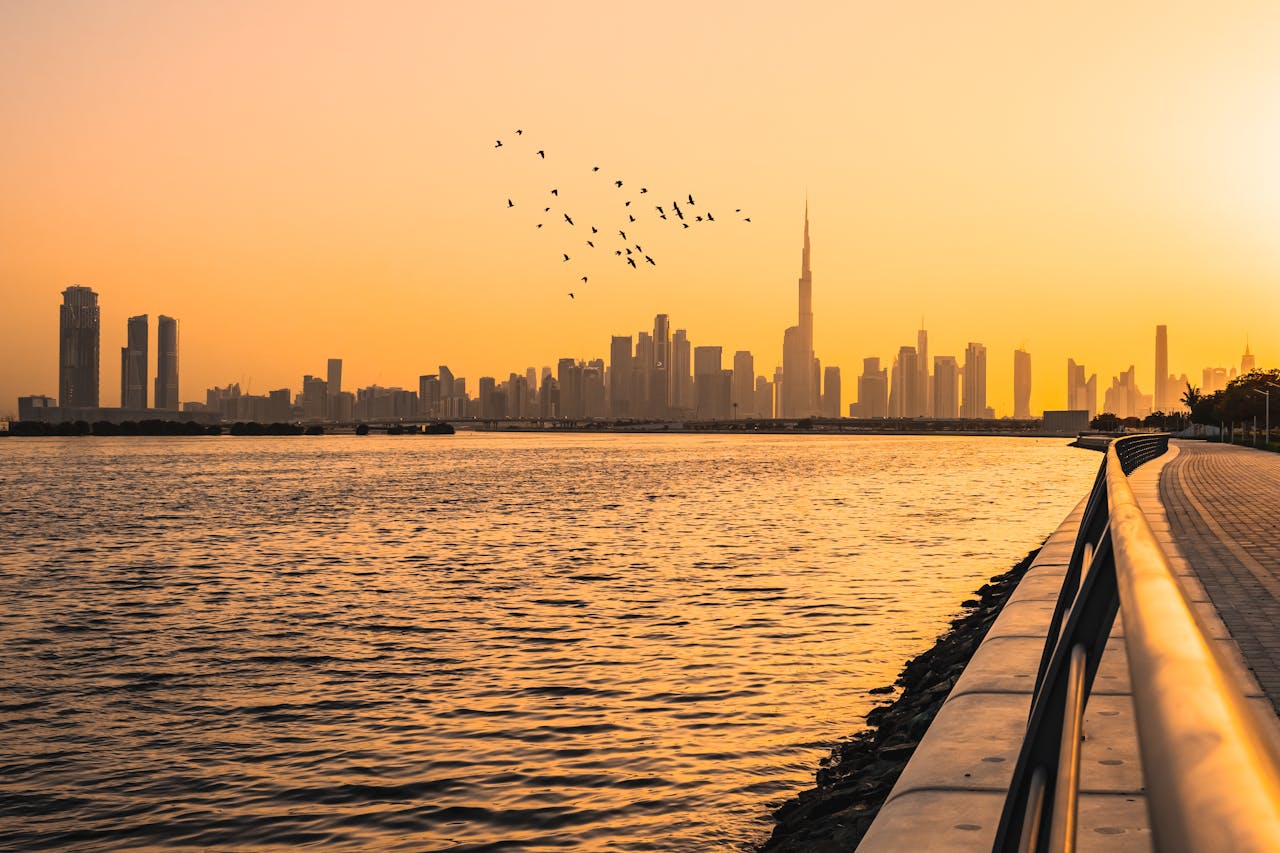I have visited Dubai in February and again in July, and they felt like different planets. February was perfect – warm enough for the beach, cool enough to walk around the old souks without melting. July was an education in extreme heat. Stepping outside felt like opening an oven door. The locals had it figured out – malls and air conditioning until sunset, then outdoor activities once the temperature dropped to a merely uncomfortable 35 degrees. Understanding Dubai’s climate is essential for planning your trip, because timing makes an enormous difference to what you can actually do there.
Dubai has a desert climate with hot summers and warm winters. Rain is rare – the city averages just 100mm annually. Here’s what to expect throughout the year.
Weather by Season
Winter (November-February)
The best time to visit. Daytime temperatures range from 24-28°C with cooler evenings around 14-19°C. Perfect for outdoor activities, beach time, and exploring the city on foot.
January is the coolest month with average highs of 24°C. This is also the wettest period, though “wet” in Dubai means perhaps 2-3 rainy days per month.
Spring (March-May)
Temperatures rise quickly. March is still pleasant (28°C average) but by May you’re looking at 37°C and higher. This is a good shoulder season if you want lower prices but can handle some heat.
Occasional Shamal winds bring dust storms, particularly in March and April. These can reduce visibility and cancel outdoor plans.
Summer (June-September)
Extremely hot. August averages 40°C but can reach 45°C or higher. Humidity increases significantly, making it feel even hotter.
This is low season with the cheapest hotel rates. Most activities happen indoors – malls, aquariums, indoor ski slopes. Pools and beaches are possible early morning or late evening.
Autumn (October)
Transitional month. Still hot (35°C average) but cooling down. Better than summer but not as comfortable as winter months.
Monthly Weather Summary
| Month | Avg High | Avg Low | Notes |
|---|---|---|---|
| Jan | 24°C | 14°C | Coolest month |
| Feb | 25°C | 15°C | Pleasant |
| Mar | 28°C | 18°C | Warming up |
| Apr | 33°C | 21°C | Getting hot |
| May | 37°C | 25°C | Hot |
| Jun | 39°C | 28°C | Very hot |
| Jul | 41°C | 30°C | Hottest period |
| Aug | 41°C | 31°C | Hottest period |
| Sep | 38°C | 28°C | Still very hot |
| Oct | 35°C | 24°C | Cooling |
| Nov | 30°C | 20°C | Pleasant |
| Dec | 26°C | 16°C | Pleasant |
Best Time to Visit
For outdoor activities: November to March. Comfortable temperatures for beach days, desert safaris, and sightseeing.
For budget travel: June to August. Extreme heat but significant hotel discounts (sometimes 50% off winter rates). Dubai Summer Surprises offers shopping deals.
For events: Dubai Shopping Festival runs January-February. Dubai World Cup horse racing is in March.
What to Pack
Winter (November-March):
- Light layers for air-conditioned interiors
- Sunscreen and sunglasses
- Swimwear for the beach and pool
- Light jacket for cooler evenings
Summer (June-September):
- Very light, loose clothing
- Hat and strong sunscreen
- Plenty of water when outdoors
- Modest clothing for mall visits
Extreme Weather
Dubai occasionally experiences:
Dust storms (Shamal): More common March-April. Can reduce visibility significantly. Check weather apps if planning outdoor activities.
Flooding: Rare but intense rain can cause flash flooding. The April 2024 storm caused significant disruption at Dubai Airport. Infrastructure isn’t designed for heavy rain.
Extreme heat: Heat waves can push temperatures beyond 45°C. Stay hydrated, avoid midday sun, and use air-conditioned transport.
Related Guides
Frequently Asked Questions
What is the best time to visit Dubai?
November to March is the best time to visit Dubai for outdoor activities. Daytime temperatures range from 24-28°C with cooler evenings around 14-19°C, perfect for beach time, desert safaris, and exploring the city on foot. January is the coolest month with average highs of 24°C.
How hot does Dubai get in summer?
Dubai summers are extremely hot, with temperatures averaging 40-41°C in July and August, sometimes reaching 45°C or higher. High humidity makes it feel even hotter. This is low season with the cheapest hotel rates, and most activities happen indoors in air-conditioned spaces.
Does it rain in Dubai?
Dubai is very dry, averaging just 100mm of rainfall annually. January is the wettest period, though “wet” in Dubai typically means only 2-3 rainy days per month. When rain does occur, it can be intense and cause flash flooding, as the city’s infrastructure isn’t designed for heavy precipitation.
What should I pack for Dubai in winter?
For Dubai’s winter months (November-March), pack light layers for air-conditioned interiors, sunscreen and sunglasses, swimwear for the beach and pool, and a light jacket for cooler evenings. Temperatures range from 24-28°C during the day and 14-19°C at night.
When is the cheapest time to visit Dubai?
June to August is the cheapest time to visit Dubai, with hotel rates sometimes 50% off winter prices. However, this is also when temperatures are extreme (40-45°C). Dubai Summer Surprises offers shopping deals during this period. The heat limits outdoor activities to early morning or late evening.
What are Shamal winds in Dubai?
Shamal winds are occasional dust storms that occur in Dubai, particularly common in March and April. These winds can reduce visibility significantly and may cause outdoor plans to be cancelled. Check weather apps if planning outdoor activities during spring months.















